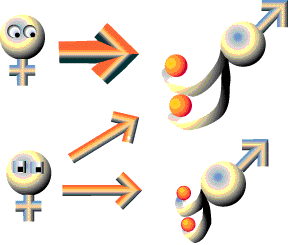 Next Generation:
Next Generation:Back to 3. Natural and Sexual Selection
The simplest model for sexual selection, female choice and a male trait assumes a haploid organism (one set of chromosomes). Let us assume that females come in two types and they are genetically based. The male trait is also genetically based:
 Next Generation:
Next Generation:
Notice that the ornamented male has a fitness of 3/2 and the plain male has a fitness of 1/2. So the ornamented male is favored by sexual selection. The next step in runaway is to consider what happens to both female choice genes and the male trait in their sons and daughters.
A table can be used to contrast the differential success of the haploid creatures: Choosy females (C) choose Elaborate males (E) and reject normal males (N), and Non-choosy females (+) choose E and N in a 50:50 ratio, with what would be expected under random mating (e.g., females only come in + types and they mate randomly):
Male Matings and Choosy Females |
Male Matings Expected by Random Female Choice | ||||||||||||||||||||||||||
|
| ||||||||||||||||||||||||||
The key step is to predict the gametes the progeny from these matings will produce in the next generation. Sons and daughters have genes for the male trait, and both sons and daughters also carry a preponderance of the choosy gene. Based on the probability of choice, a male parent receives 1 share of his matings from choosy females, and 1/2 share of his matings from non-choosy females. Thus, from the point of view of the male genes and progeny, 66% of the male Elaborate trait genes in the population are associated with the female trait gene. In contrast, a mere 33% of the Elaborate trait genes are associated with the non-choosy female gene. In addition, all Normal males breed with non-choosy females and thus 100% of the the Normal male genes (all of them) are associated with non-choosy females (conversely 0% of the Normal genes are associated with choosy females.
Because the combination of Elaborate male allele is combined with the alleles for Choosy females in progeny, more offspring are produced with this combination. This occurs every generation and the choosy females and elaborate males both benefit and enjoy high fitness.
Both of these facts mean that choosy genes and elaborate male genes occur in a higher frequency than one would expect if the population were mating non-randomly. The central prediction of runaway process is that female choice and the male trait should become genetically correlated or the choosy gene becomes genetically linked to the non-choosy gene. It is more likely that you find a choosy gene associated with the male trait, or vice versa that you will find a non-choosy gene associated with the drab male gene. What happens each generation is that both the gene for female choice and the male trait become correlated. Note that 1/2 the progeny have both genes for choice and the exaggerated trait.
If we continue this process, generation after generation, all of the daughters of the choosy females have both the choice gene and the male trait gene. This means that females will be producing sons and daughters with both choice and exaggerated trait genes together. Because the exaggerated males have an advantage in subsequent generations and because the choosy female genes are genetically correlated with the male trait, Female Choice and the male trait spread, and they spread together, almost like a wild fire, or as Fisher termed a Runaway Process.
More importantly the genes for female choice and the genes for the male trait become linked in the progeny (even though they are not on the same chromosome). Such linkage by the process of assortative mating leads to the runaway, because the Elaborate males who are chosen with high frequency produce lots of daughters who are likewise quite choosy. A critical prediction of Runaway process is that female choice should be genetically correlated with the genes for male choice. Another key aspect of Kirkpatrick and Lande's formulation of Fisherian runaway sexual selection that I have ignored for the moment is that the male ornament will increase in frequency even if it is costly in terms of male survival.